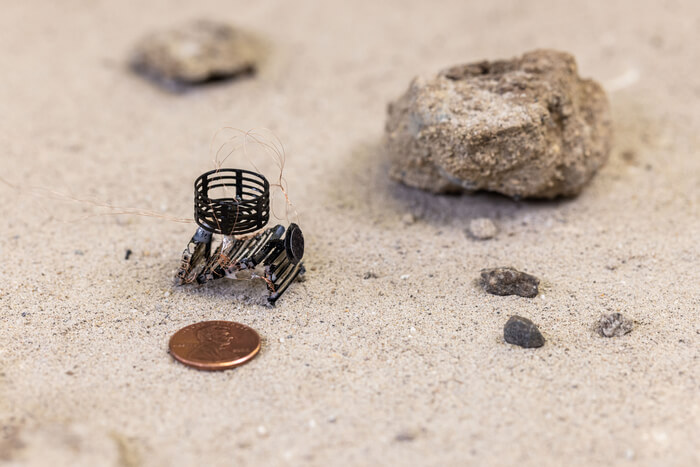Engineers at UCLA have unveiled a new method of printing functional miniature robots that can be manufactured with a single printing process.
The little fingernail-sized robots, dubbed meta-bots are printed with their mechanical and electrical systems complete, and this is achieved by use of piezoelectric metamaterials.
Typically, piezoelectric actuation only has a single degree of freedom when a single crystal is used. However, by use of 3D printing, the engineers were able to not only increase the number of degrees of freedom allowing more complex movements, but were able to couple mechanical strain with electrical fields therefore allowing not only propulsion, but motion in multiple degrees of freedom, decision making, and the capacity for ultrasonic sensing also. The sensing capability is able to measure the movement in its own structure also, meaning that the robots have the ability for feedback control.
You can see the tiny meta-bot in the image below.

The robots work thanks to the printed lattice structure which can respond physically and move when placed in an electric field. Conversely, when mechanical force is applied to the piezoelectric lattice, it can create an electric field.
The process used to create the lattice structures is some form of resin-based method where the piezoelectric inks are solidified into piezoelectric ceramics with additional metal internals.
You can see the process and some footage of the little robots navigating mazes in the video below. Check it out. It’s fun to watch.
The robots have the potential to be miniaturized even further and the researchers say that one day they may be so small that they can be sent into human blood vessels where they can deliver drugs to specific sites.
The robots are battery powered, and can be fitted with an onboard battery or a remote battery, connected to the robot via a thin wire.
“We envision that this design and printing methodology of smart robotic materials will help realize a class of autonomous materials that could replace the current complex assembly process for making a robot,” said Xiaoyu Zheng, an associate professor working on the project at the UCLA Samueli School of Engineering.
“With complex motions, multiple modes of sensing and programmable decision-making abilities all tightly integrated, it’s similar to a biological system with the nerves, bones and tendons working in tandem to execute controlled motions.”
The robots are programmable and the function of the robot can be determined by the purpose built lattices. So far three robots have been demonstrated, with one being capable of random object avoidance, the other being capable of responding to impacts and the third being able to traverse rough terrain (as you can see in the video above).
In addition to the potential for drug delivery inside the human body, the researchers say that in future the robots could even be used for threat assessment and environmental sensing in hazardous areas.
The findings have been published in the Science journal in a paper titled “Design and printing of proprioceptive three-dimensional architected robotic metamaterials”. You can read that paper over at this link.










